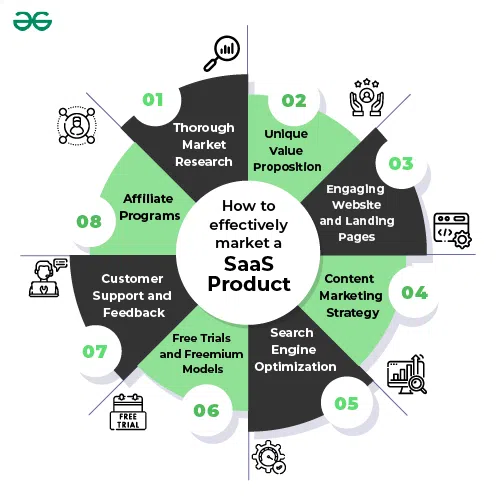How to market a SaaS product?
Last Updated :
22 Dec, 2023
In today’s changing world, Software as a Service (SaaS) products have completely revolutionized how businesses operate. These cloud-based solutions provide flexibility, scalability and cost-effectiveness making them an essential asset for companies aiming to be efficient and innovative. However, simply having a SaaS product may not guarantee success in a competitive market. It is imperative to have a marketing strategy that not only creates brand awareness, but also establishes a strong customer base. In this guide, we delve into the elements and best practices for successfully marketing a SaaS product.

What is a SaaS product?
SaaS, also known as Software as a Service, refers to a software delivery model that operates through the cloud. This allows users to access applications over the internet. Unlike software solutions, SaaS products eliminate the need for installations and regular maintenance tasks. Consequently, they become easily accessible from any device connected to the internet. They provide solutions such as customer relationship management (CRM) platforms or project management tools that enable businesses to streamline their operations in an effective manner.
How can you effectively market a SaaS product?
1. Thorough Market Research:
To successfully market a SaaS product, it is vital to understand your target audience and their pain points. To effectively understand your target market, it is essential to conduct market research. This will help you identify the requirements and difficulties that your potential customers face. By conducting this research, you can gain insights into customer preferences, industry trends and the competitive landscape. Armed with this knowledge, you can then customize your marketing strategy to meet these needs.
2. Unique Value Proposition (UVP):
Another crucial aspect is developing a Unique Value Proposition (UVP) that clearly communicates the advantages offered by your SaaS product. It should be compelling. Highlight the benefits that set your product apart from others in the market. To effectively market your product to your target audience and stand out from competitors, it is crucial to focus on addressing pain points improving efficiency and providing an experience.
3. Engaging Website and Landing Pages:
Creating an engaging and user website that showcases the features, benefits and value proposition of your SaaS product is key. Incorporating appealing landing pages that highlight functionalities and solutions can help captivate potential customers. Building trust and credibility among website visitors can be achieved by including visuals, customer testimonials and case studies.
4. Content Marketing Strategy:
Additionally developing a content marketing strategy is vital. This strategy should aim to educate, inform and engage your target audience. Creating high quality content such as blog posts, case studies, whitepapers and videos that address industry challenges while offering insights will position your SaaS product as the solution. By demonstrating its effectiveness and reliability through content marketing efforts you can further establish its value.
5. Search Engine Optimization (SEO):
Implementing a search engine optimization (SEO) strategy is essential for improving visibility and expanding reach. Conducting keyword research to identify search terms used by your target audience will allow you to optimize your website content accordingly. Make sure to prioritize the creation of informative content that appeals to both search engines and your intended audience. This will ultimately lead to an increase in traffic to your website.
6. Free Trials and Freemium Models:
Consider offering trials or freemium versions of your SaaS product. This allows potential customers to experience the value it provides firsthand. It’s important to provide a trial period that’s long enough for users to grasp the capabilities and benefits of your product fully. Take advantage of this opportunity to highlight the features that make your product stand out from the competition, ultimately encouraging users to become paying customers.
7. Customer Support and Feedback:
Deliver customer support to establish trust and credibility with your customers. Encourage lines of communication, actively seek feedback to gain a better understanding of your customer’s experiences and expectations. Use customer feedback as a resource for improving your product, promptly addressing any issues and demonstrating your dedication to customer satisfaction and success.
8. Affiliate Programs:
Collaborate with businesses that complement yours industry influencers and affiliates to expand your market presence and enhance credibility. Create partnerships and affiliate programs that encourage collaboration and mutual growth. By leveraging the networks and expertise of trusted partners, you can significantly boost visibility and reputation of your SaaS product, attracting a customer base.
Conclusion:
Effectively marketing a SaaS product requires an approach that encompasses an understanding of the target audience, an appealing value proposition engaging content, as well as robust customer support. By implementing these practices, SaaS companies can position their products effectively in the market while differentiating themselves from competitors—ultimately building long term relationships with customers. To maintain growth and achieve success in the SaaS industry, it is essential to prioritize customer needs and stay updated with market trends and customer feedback.
Share your thoughts in the comments
Please Login to comment...